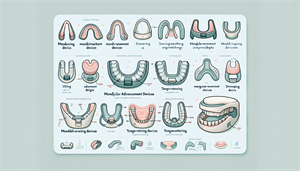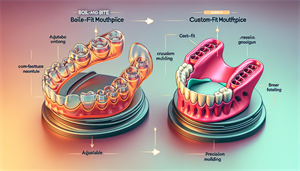A snoring mouthpiece is a dental device that helps reduce snoring by keeping the airway open during sleep. It works by adjusting the position of your jaw or tongue, minimizing airway blockage and the noise of snoring.
This article will cover the basics of "what is a snoring mouthpiece?", how it works, and who can benefit from using one.
Key Takeaways
-
Snoring mouthpieces are designed to keep airways open by repositioning the jaw or tongue, providing relief for chronic snorers and those with obstructive sleep apnea.
-
Choosing the right snoring mouthpiece, which advances your jaw, holds your tongue, or a combination of both, depends on individual needs, comfort, and dental health.
-
Regular maintenance, including cleaning and periodic adjustments, is essential for the longevity and effectiveness of snoring mouthpieces, while being aware of potential side effects helps ensure a positive user experience.
Understanding Snoring Mouthpieces

A snoring mouthpiece is a dental device designed to minimize snoring by adjusting the position of the jaw or tongue. The primary purpose of these devices is to keep the airway open during sleep, thereby reducing the snoring noise that can disrupt a good night’s sleep.
Individuals with mild to moderate obstructive sleep apnea and chronic snorers are the primary beneficiaries of these innovative snoring solutions.
These devices are not limited to those with sleep apnea; they can also provide relief for anyone struggling with snoring, making them a versatile and accessible option for many, including the use of an anti snoring device.
Alternative Names For Snoring Mouthpieces
Snoring mouthpieces go by several names, including Mandibular Advancement Device (MAD), Oral Appliance Therapy (OAT) device, snore guard, snoring mouthguard, anti-snoring device, sleep apnea mouthpiece, dental sleep device, jaw advancing device, and tongue retaining device (TRD).
These names often reflect the device's specific function or design, but are frequently used interchangeably in discussions about snoring solutions.
Definition and Purpose
A snoring mouthpiece is designed to prevent snoring by keeping the airway open. These devices work by adjusting the position of the lower jaw or tongue to prevent the airway from collapsing. Snoring often occurs when the soft tissues in the airway collapse and obstruct the airflow, leading to the characteristic snoring sound.
Targeting the root cause of snoring, these best anti snoring mouthpiece can effectively reduce or eliminate the noise, resulting in more restful and uninterrupted sleep for both the snorer and their bed partner. If you want to stop snoring, consider trying an anti snoring mouthpiece.
Who Can Benefit from a Snoring Mouthpiece?
Snoring mouthpieces can benefit a wide range of individuals, particularly those with simple snoring who do not have dental issues or specific medical conditions. Chronic snorers often realize that their snoring may keep others awake, highlighting the importance of addressing this issue for the sake of everyone’s sleep quality.
Individuals diagnosed with obstructive sleep apnea should seek a proper diagnosis before obtaining customized treatment. Oral appliance therapy offers an alternative for those who find CPAP machines difficult to use, helping to alleviate snoring and improve sleep quality.
History Of Snoring Mouthpieces
The history of snoring mouthpieces began in the early 20th century, rooted in dental and orthodontic practices. In the 1930s, French stomatologist Pierre Robin developed the "monobloc" device, inadvertently laying the groundwork for future snoring solutions.
The 1980s saw dentists and sleep specialists exploring non-invasive snoring treatments. Dr. W. Keith Thornton's development of a commercially successful anti-snoring device in 1990, later evolving into the TAP (Thornton Adjustable Positioner), marked a significant milestone.
The late 1990s brought advancements with thermoplastic materials, leading to "boil-and-bite" devices. Today's market offers a wide range of options, from over-the-counter solutions to custom-made devices, reflecting growing awareness of sleep disorders and demand for effective treatments.
How Do Snoring Mouthpieces Work?

Snoring results from air resistance in the upper airway due to relaxed throat tissues. Snoring mouthpieces help alleviate snoring by managing the position of the jaw and tongue during sleep.
There are various types of anti-snoring devices, including those that expand the airway and those that hold the tongue in place. Oral appliances help maintain an open airway during sleep, enhancing airflow and reducing snoring.
These devices address the physical causes of snoring directly, making them a practical solution for many suffering from sleep issues.
Jaw Advancement Mechanism
Mandibular Advancement Devices (MADs) function by moving the jaw forward and apart, helping to open the airway. They help reduce snoring by moving the jaw forward to expand breathing passages. These devices apply pressure to move the jaw forward using a fixed connection, which makes the soft tissues tense and prevents them from collapsing.
Some products have a fixed position for jaw advancement, while others allow for incremental adjustment. This mechanism effectively opens the airway, allowing for better airflow and reducing the snoring noise.
Tongue Stabilization Mechanism
Tongue Stabilizing Devices (TSDs) secure the tongue to minimize airway blockage. By holding the tongue forward, usually with a suction bulb or rubber strap, these devices prevent the tongue from obstructing the airway during sleep, thus reducing snoring. This mechanism is particularly beneficial for individuals who cannot use MADs due to dental or jaw-related issues.
Types of Snoring Mouthpieces
Snoring mouthguards can be classified mainly into two categories: Mandibular Advancement Device (MADs), and Tongue-Retaining Devices (TRDs). Each type has its unique mechanism and suitability depending on the user’s needs and preferences.
While MADs work by repositioning the lower jaw to keep the airway open, TRDs hold the tongue forward to prevent airway obstruction.
Selecting the right snoring mouthpiece depends on understanding these types. While MADs are more popular and widely used, TRDs can be the best option for those with specific needs or discomfort with MADs.
Mandibular Advancement Devices (MADs)
Mandibular Advancement Devices (MADs) are specifically designed for the treatment of snoring and mild to moderate obstructive sleep apnea.
These devices function by moving the lower jaw forward. This action helps maintain an open airway and lessens the chances of snoring.
The benefits of using MADs include:
-
Reducing snoring
-
Improving daytime sleepiness
-
Lowering blood pressure
-
Enhancing overall quality of life
There are two main types of MADs: one-piece and two-piece devices, catering to various preferences and needs. This variety ensures that users can find a device that fits comfortably and works effectively for their specific situation.
Tongue-Retaining Devices (TRDs)
Tongue-retaining devices (TRDs) typically feature a design that secures the tongue forward to prevent it from obstructing the airway. These devices are designed to hold the tongue in a forward position, which helps in preventing airway obstruction during sleep. TRDs are generally easier to wear and are lighter compared to MADs, making them suitable for some individuals who cannot use MADs.
Individuals who find MADs uncomfortable or unmanageable may find TRDs a more suitable alternative for preventing snoring. This makes TRDs a valuable option in the range of snoring solutions available.
Benefits of Using a Snoring Mouthpiece

Snoring mouthpieces are often associated with improved sleep quality by promoting more restful sleep. These devices are generally a cost-effective alternative to surgical options for addressing snoring issues and offer a more straightforward solution compared to treatments like CPAP machines.
Dentist custom-fit mouthpieces are usually more effective than boil-and-bite options due to their tailored design, but they are often much more expensive and time consuming to obtain.
The overall benefits of using a snoring mouthpiece make them an attractive option for those looking to reduce snoring and improve their sleep quality without resorting to invasive procedures.
Improved Sleep Quality
Using a snoring mouthpiece can lead to more restorative sleep and lower levels of morning grogginess. Users report a significant reduction in nighttime wakefulness when using snoring mouthpieces. This improved sleep quality can enhance cognitive performance and focus throughout the day.
Reduced snoring can also lead to a more peaceful sleep environment, benefiting not just the snorer but also their bed partner. This can result in better overall quality sleep and a restful night’s sleep health and well-being for everyone involved.
Better Daytime Functioning
Reduced snoring can lead to better attitudes and happier mornings, enhancing daytime productivity and alertness. Many individuals wake up feeling more refreshed and ready to tackle the day when snoring is minimized or eliminated.
Some users might experience increased saliva production shortly after inserting a snoring mouthpiece. Although this can affect comfort and sleep quality initially, it typically subsides as the user becomes accustomed to the device.
Non-Invasive Solution
Snoring mouthpieces offer a non-surgical approach to managing snoring, making them appealing for many users. They present a simpler and less risky alternative compared to traditional medical interventions for snoring.
Choosing the Right Snoring Mouthpiece

Choosing the right snoring mouthpiece is crucial for effectiveness and comfort. Over-the-counter mouthguards may not effectively address individual snoring issues and can potentially worsen the situation. Consulting with a sleep dentist can help obtain a custom mouthguard tailored to individual dental needs, ensuring a better fit and more effective treatment.
Subtle differences in design and materials can significantly impact the comfort and effectiveness of anti snoring mouth guard and anti snoring mouthpieces. Typically, these devices last between six to nine months, though factors like teeth grinding can shorten their lifespan. Consistent use is key to achieving the desired results.
Boil-and-Bite vs. Custom-Fit
Boil-and-bite mouthpieces can be customized by warming the device in hot water and molding it to the shape of the teeth. Some mandibular advancement devices (MADs) feature this customization method, allowing for a better fit to the user’s mouth shape. However, custom-fit mouthpieces involve a professional fitting process where a dentist takes impressions of the teeth to create a personalized device.
While boil-and-bite options are generally less expensive, custom-fit mouthpieces can cost significantly more but offer a tailored solution. The advantage of custom-made mouthpieces is that they mold precisely to the user’s teeth, ensuring better comfort and effectiveness.
Individuals looking for a cost-effective remedy might prefer boil-and-bite mouthpieces, while those seeking comfort and precision may opt for custom-fit solutions.
Comfort and Fit Considerations
Choosing a snoring mouthpiece made from softer materials can greatly enhance comfort during use. Many users might experience mild to moderate jaw pain initially when wearing a mouthpiece. Some users might also experience tooth sensitivity and discomfort in jaw muscles after prolonged use of snoring mouthpieces.
Soreness in teeth and gums can arise but typically resolves quickly after removing the device. A good fit and selecting a mouthpiece made from quality materials can mitigate these issues and provide a more comfortable experience.
Material and Durability
The quality of materials in a snoring mouthpiece plays a crucial role in its performance and effectiveness. SnoreMD’s mouthpiece, made from premium dental-grade copolymers, ensures comfort and safety. High-quality materials contribute not only to the effectiveness of the mouthpiece but also enhance its durability over time.
Proper Use and Maintenance of Snoring Mouthpieces
Proper use and maintenance of snoring mouthpieces ensure their longevity and effectiveness.
Follow-up visits after starting to use a mouthpiece are important to adjust the fit and address any side effects. While these devices are generally safe for adults, consulting a dentist if any medical conditions exist is advised.
Maintaining a cleaning routine, making regular adjustments, and proper storage can significantly prolong the life of the mouthpiece and maintain its effectiveness.
Daily Cleaning Routine
Daily brushing with toothpaste and water maintains the cleanliness of the mouthpiece. Cleaning solutions like tablets can also help.
Storing the mouthpiece in a cool, dry environment helps prolong its lifespan and prevents damage. Avoid using products that are too aggressive when cleaning a snoring mouthpiece to prevent damage to the material.
Adjustment Period
It may take a few days or weeks to get used to wearing a snoring mouthpiece. This is because it can adjust your jaw position.
Device Adjustments
Depending on the mouthpiece, you may need to adjust it to incrementally advance your jaw. This is because adjusting it all at once can be uncomfortable.
Periodic follow-ups with healthcare professionals can help optimize the effectiveness of snoring mouthpieces and ensure long-term comfort and functionality.
Storage Tips
A storage case is often included with mouthpieces to protect them when not in use. It’s important to keep the mouthpiece dry and away from pets to prevent contamination or damage. Proper storage is crucial to maintain the condition of your snoring mouthpiece.
By using a storage case and keeping the mouthpiece dry, you can ensure its longevity and hygiene.
Potential Risks and Side Effects
Using anti-snoring mouthpieces may lead to temporary discomfort and adjustments in oral structure. These potential risks and side effects are generally mild but can vary among users. Being aware of these possibilities and monitoring any changes while using the device is important.
Understanding the common side effects and knowing when to consult a professional can help mitigate these risks and ensure a positive experience with snoring mouthpieces.
Common Side Effects
Common side effects of using snoring mouthpieces often occur but are generally mild. Jaw discomfort is prevalent among users. Other side effects include dry mouth and drooling, but these typically resolve on their own.
These side effects can vary in occurrence among users, and most find that any initial discomfort diminishes with continued use. Monitoring these side effects and consulting with a professional if they persist can help ensure a comfortable and effective experience.
When to Consult a Professional
If symptoms such as persistent jaw pain or difficulty in breathing occur, seek medical advice regarding the use of mouthpieces. Consulting a dental professional if persistent pain or discomfort occurs is crucial to prevent any long-term issues.
It is crucial to seek professional consultation if you experience any severe or persistent issues while using a snoring mouthpiece. This ensures that any underlying conditions are addressed, and appropriate adjustments or treatments are provided.
Summary
In summary, snoring mouthpieces offer a practical and non-invasive solution for reducing snoring and improving sleep quality. By understanding the different types of mouthpieces, how they work, and who can benefit from them, individuals can make informed decisions about their snoring solutions.
The benefits of improved sleep quality, better daytime functioning, and a non-invasive approach make these devices an attractive option for many.
Choosing the right snoring mouthpiece involves considering factors such as comfort, fit, material quality, and consulting with a professional if needed. Proper use and maintenance are crucial to ensure the longevity and effectiveness of the mouthpiece.
While there may be potential risks and side effects, most users find these to be manageable and worth the benefits. Embrace the journey to better sleep and a quieter night with the right snoring mouthpiece.
Frequently Asked Questions
How does a snoring mouthpiece work?
A snoring mouthpiece works by repositioning your jaw or tongue to keep your airway clear while you sleep, which helps minimize snoring. It's a simple way to improve your sleep quality and that of your partner!
Who can benefit from using a snoring mouthpiece?
If you snore occasionally, chronically, or have obstructive sleep apnea, a snoring mouthpiece can really help improve your sleep quality. It's a great solution for a range of snoring issues!
What are the common side effects of using a snoring mouthpiece?
Using a snoring mouthpiece may lead to mild side effects like jaw discomfort, dry mouth, and drooling. However, many people find these issues manageable.
How do I choose the right snoring mouthpiece?
To choose the right snoring mouthpiece, focus on the fit (whether it's boil-and-bite or custom), ensure it's comfortable, and check the material quality. It's also wise to consult a professional for tailored advice.
How should I maintain my snoring mouthpiece?
To keep your snoring mouthpiece in top shape, clean it daily with toothpaste and water, use a cleaning solution weekly, and always store it in a cool, dry place. This simple routine will ensure it stays fresh and effective!


